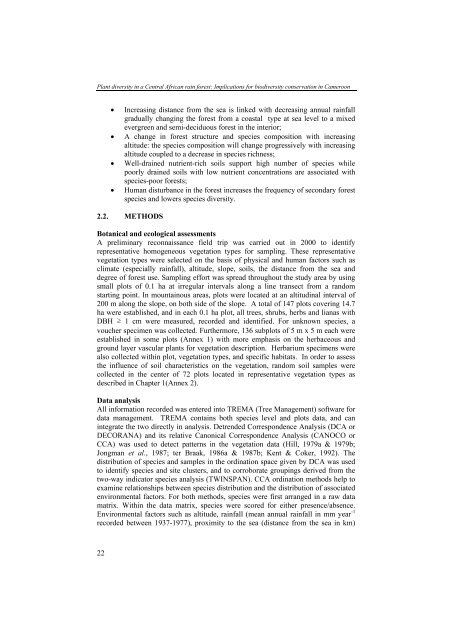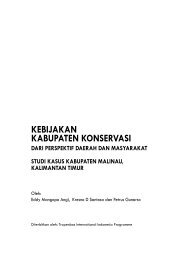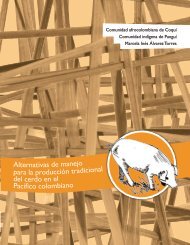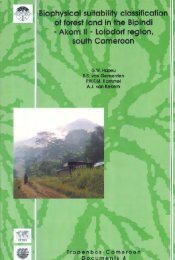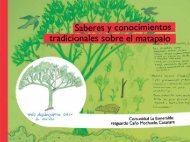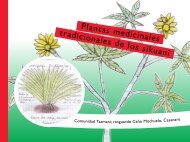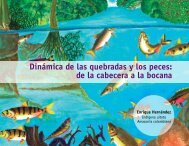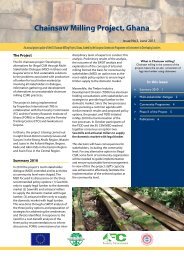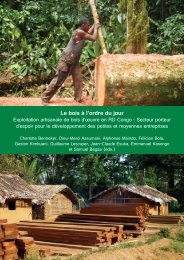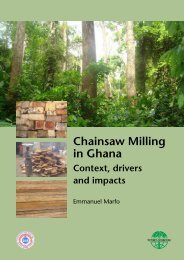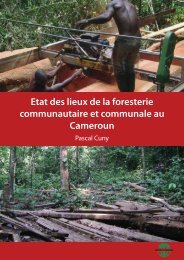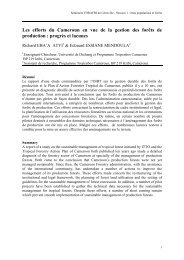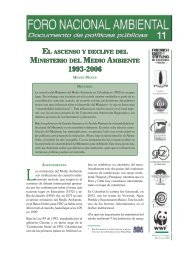Download the publication - Tropenbos International
Download the publication - Tropenbos International
Download the publication - Tropenbos International
Create successful ePaper yourself
Turn your PDF publications into a flip-book with our unique Google optimized e-Paper software.
Plant diversity in a Central African rain forest: Implications for biodiversity conservation in Cameroon<br />
22<br />
• Increasing distance from <strong>the</strong> sea is linked with decreasing annual rainfall<br />
gradually changing <strong>the</strong> forest from a coastal type at sea level to a mixed<br />
evergreen and semi-deciduous forest in <strong>the</strong> interior;<br />
• A change in forest structure and species composition with increasing<br />
altitude: <strong>the</strong> species composition will change progressively with increasing<br />
altitude coupled to a decrease in species richness;<br />
• Well-drained nutrient-rich soils support high number of species while<br />
poorly drained soils with low nutrient concentrations are associated with<br />
species-poor forests;<br />
• Human disturbance in <strong>the</strong> forest increases <strong>the</strong> frequency of secondary forest<br />
species and lowers species diversity.<br />
2.2. METHODS<br />
Botanical and ecological assessments<br />
A preliminary reconnaissance field trip was carried out in 2000 to identify<br />
representative homogeneous vegetation types for sampling. These representative<br />
vegetation types were selected on <strong>the</strong> basis of physical and human factors such as<br />
climate (especially rainfall), altitude, slope, soils, <strong>the</strong> distance from <strong>the</strong> sea and<br />
degree of forest use. Sampling effort was spread throughout <strong>the</strong> study area by using<br />
small plots of 0.1 ha at irregular intervals along a line transect from a random<br />
starting point. In mountainous areas, plots were located at an altitudinal interval of<br />
200 m along <strong>the</strong> slope, on both side of <strong>the</strong> slope. A total of 147 plots covering 14.7<br />
ha were established, and in each 0.1 ha plot, all trees, shrubs, herbs and lianas with<br />
DBH ≥ 1 cm were measured, recorded and identified. For unknown species, a<br />
voucher specimen was collected. Fur<strong>the</strong>rmore, 136 subplots of 5 m x 5 m each were<br />
established in some plots (Annex 1) with more emphasis on <strong>the</strong> herbaceous and<br />
ground layer vascular plants for vegetation description. Herbarium specimens were<br />
also collected within plot, vegetation types, and specific habitats. In order to assess<br />
<strong>the</strong> influence of soil characteristics on <strong>the</strong> vegetation, random soil samples were<br />
collected in <strong>the</strong> center of 72 plots located in representative vegetation types as<br />
described in Chapter 1(Annex 2).<br />
Data analysis<br />
All information recorded was entered into TREMA (Tree Management) software for<br />
data management. TREMA contains both species level and plots data, and can<br />
integrate <strong>the</strong> two directly in analysis. Detrended Correspondence Analysis (DCA or<br />
DECORANA) and its relative Canonical Correspondence Analysis (CANOCO or<br />
CCA) was used to detect patterns in <strong>the</strong> vegetation data (Hill, 1979a & 1979b;<br />
Jongman et al., 1987; ter Braak, 1986a & 1987b; Kent & Coker, 1992). The<br />
distribution of species and samples in <strong>the</strong> ordination space given by DCA was used<br />
to identify species and site clusters, and to corroborate groupings derived from <strong>the</strong><br />
two-way indicator species analysis (TWINSPAN). CCA ordination methods help to<br />
examine relationships between species distribution and <strong>the</strong> distribution of associated<br />
environmental factors. For both methods, species were first arranged in a raw data<br />
matrix. Within <strong>the</strong> data matrix, species were scored for ei<strong>the</strong>r presence/absence.<br />
Environmental factors such as altitude, rainfall (mean annual rainfall in mm year -1<br />
recorded between 1937-1977), proximity to <strong>the</strong> sea (distance from <strong>the</strong> sea in km)


